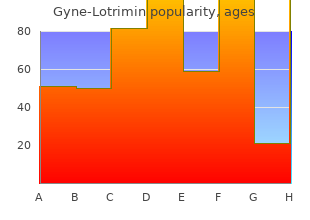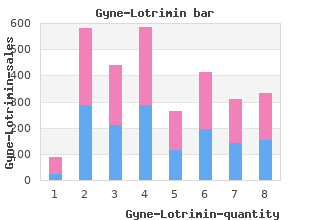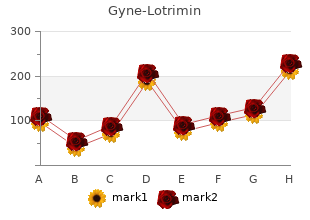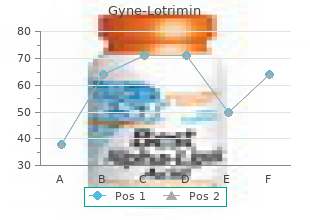Gyne-Lotrimin
"Order generic gyne-lotrimin from india, menopause the musical reviews".
By: R. Dudley, M.B. B.CH. B.A.O., M.B.B.Ch., Ph.D.
Assistant Professor, Kansas City University of Medicine and Biosciences College of Osteopathic Medicine
Medical professionals have become more motivated with the improvement in working conditions and are now able to menstrual android purchase gyne-lotrimin 100mg with mastercard provide the best possible care to pregnancy quad screen purchase generic gyne-lotrimin pills their patients menopause experts discount gyne-lotrimin 100 mg on-line. Patients are also satisfied that they are receiving modern radiotherapy treatment in their home country. Finally, there will be a positive financial impact resulting from the substantial decrease in costs of patients� treatments made possible by building radiotherapy capacity in the country. These are concrete and effective actions taken by an international organization in the fight against cancer, and represent the investment of significant resources that have resulted in improved infrastructure, an expanded workforce and increased access for patients to modern diagnosis and treatment. The establishment of radiotherapy services is essential to consolidate any national cancer control plan. There are still many countries without a single radiotherapy department, especially in Africa, and many others have very low coverage. Establishing a radiotherapy programme requires careful planning, including the requirement for successive phases. Resources should be available for designing, building, purchasing, maintaining and replacing equipment, and for providing training in its use. In the case of a first radiotherapy facility with basic staffing levels, there is not likely to be enough expertise to guide and oversee the process in many or all of these areas. The first step in the process should be to prepare a strategic master planning document that includes not only a detailed analysis of the needs and timelines, but also the medium and long term plans for future expansion of the services. The lack of such a master plan can result in important components of the process being inadvertently left out, an inadequate or unrealistic timeline, or unexpected costs when expanding the facility. The architectural design is also very important, as the radiotherapy facility should not only have enough space to house treatment and diagnostic equipment, clinics and planning facilities, but there should also be a proper connection between them to ensure a smooth workflow. The easiest way to begin is to install a basic machine first and, when the staff members are confident, a second one that is more complex. A simple basic machine � a telecobalt or monoenergetic linear accelerator (linac) � will be cheaper to acquire and to maintain and easier to commission, and there will be less downtime. The investment required to install and run a multimodality linac is double the cost of a basic machine, or equal to the initial and running costs of two basic machines. Twice the number of patients can be treated with two basic machines, which is a strong argument when access to services needs to be prioritized. These documents frequently lack sufficient detail, especially on the conditions of the ongoing maintenance contract. The timeline is critical and should include all preparatory work needed, including training of professional staff and construction of the building. There have been instances where a building was completed and the equipment installed, but the staff returned from training abroad only after many years, and it was necessary to hire foreign personnel to run the facility in the meantime. There have been other instances where the professional staff came back and the radiotherapy facility was not yet ready. It should also be emphasized that long term training abroad for professional staff is very costly, and recognition, registration and employment of personnel should therefore be planned in advance. Governments should also have a retention policy in place to discourage the emigration of trained professional staff. A rule of thumb is that equipment maintenance is approximately 10% of the purchase cost per year. Another 10% per year should be saved as amortization to replace the equipment in 10�15 years. The other components are salaries, 497 consumables, and building maintenance and amortization. Thus, the initial price of equipment should be multiplied by 2 in a ten year period to cover maintenance and amortization [29. A programme to encourage development and continuous education of professional staff should be part of the retention policy mentioned above. This should be based on the establishment of training programmes at the national level [29. In many ways, the process will replicate everything that happened when establishing the first facility in terms of timeline, training, selection of equipment, buildings, etc.

Ne u re ct o m y p ro ce d u re s Ve s t i b u l o c o c h l e a r n e r v e s e c t i o n (b a s e d o n e a r l y p o s t e r i o r fo s s a s u r g e r y b y Da n d y; e n t i r e e i g h t h nerve bundle was sectioned in 587 patients; all were deaf post-op): 90% relieved of vertigo women's health endometriosis buy gyne-lotrimin without a prescription, 5% unchanged and 5%worse; 9%incidence of facial paralysis (3%incidence of permanent paralysis) menopause jokes humor cheap gyne-lotrimin 100mg. Re t r o la b yr in t h in e a p p r o a ch: in 3 2 p a t ie n t s w it h M e n ie r e �s syndrome (25 failed endolymph shunt) responding to menstrual age buy generic gyne-lotrimin 100 mg survey, 85%had complete relief of vertigo, 6%improved, 9%no relief (one of whom responded to middle fossa neurectomy). If an y vest ibu lar n e r ve fu n ct ion is d em on st rate d on op erate d sid e, then the nerve section was incomplete; consider re-operating. The keys to di erentiating central paralysis (due to supranuclear lesions) from peripheral facial palsy are that central palsies: 1. In nuclear facial palsies, other neurologic findings also often occur from involvement of adjacent neural structures by the underlying process (stroke, tumor). Fa c i a l n e r v e l e s i o n Motor fibers ascend within the pons and form a sharp bend (�internal genu�) around the sixth nerve (abducens) nucleus, forming a visible bump in the floor of the 4th ventricle (facial colliculus). The seventh nerve exits from the brain stem at the ponto-medullary junction (Fig. Th e ge n icu la t e ga n glio n (�external genu�) is located within the temporal bone. The next branch is the branch to the stapedius muscle; lesions proximal to this point produce hyperacusis. Next,the chorda tympanijoins the facial nerve bringing taste sensation from the anterior two�thirds of the tongue. Travelling w ith the chorda tym pani are fibers to the sub mandibular and sublingual glands. It then enters the parotid gland, where it splits into the following branches to the facial muscles (crani al to caudal): temporal, zygomatic, buccal, mandibular, and cervical. Note: 90�95%of all cases of facial palsy are accounted for by Bell�s palsy, 9 herpes zoster oticus, and trauma (basal skull fractures). Facial neuromas account for 5%of peripheral facial nerve pal 10 sies; the paralysis tends to be slowly progressive b) parotid tumors may involve some branches but spare others c) Masson�s vegetant intravascular hemangioendothelioma (p. Most cases probably represent a viral inflam m atory 15 16 demyelinating polyneuritis usually due to the herpes simplex virus. Fa c ia l p a ls y d u e t o Ly m e d is 17 ease can usually be recognized on clinical grounds. Se ve r it y m ay b e grad e d on t h e Hou se & Br ack mann grading scale (see Ta b le 4 1. Usu ally e xh ibits d ist al t o p roxim al p rogression: motor branches, then chorda tympani (loss of taste and decreased salivation), then stapedial branch (hyperacusis), then geniculate ganglion (decreased tearing). He r p e s z o s t e r ve sicle s d e velo p in 4 % o f patients 2�4 days after onset of paralysis; and in 30%of patients 4�8 days after onset. During the recovery phase excessive lacrimation may occur (aberrant nerve regeneration). Ar t ificia l t e a r s d u r in g t h e d a y, e ye o in t m e n t a t n ig h t, avoid bright light (using dark glasses during the day). Su rg ica l m a n a g e m e n t Su r gical d e com p r e ssion: con t r oversial. Ext e n t of recovery: 75�80%of cases recover completely, 10%partial, remainder poor. If recovery begins by 10�21 d, tends to be complete; if not until 3�8 wks > fair, if n ot u n til 2�4 mos > poor recovery. Cases of incomplete paralysis at onset that do not progress to complete paralysis > complete recovery; incomplete paralysis at onset that progresses to complete > incom plete recovery in 75%. A functional neural repair is not possible if the facial muscles have atrophied or fibrosed. When the status of the nerve is unknown or if in continuity but not functioning, then several m onths of observation and electrical testing should be allowed for spontaneous recovery. Very late attempts at anastomosis have less chance for recovery due to facial muscle atrophy. The resultant facial reanimation is often less than ideal (m ay perm it m ass m ovem ent). To avoid severe disappointm ent, the patient should thoroughly understand the likely side e ects and that the facial movement will probably be much less than norm al, often w ith poor voluntary control. Usually perform ed in conjun ction w ith an astam osis of th e descen den s hypoglossi to th e distal hypoglossal nerve to try and reduce hemiatrophy of the tongue. Skin incision: 6�8cm incision from just above the mastoid process obliquely downward across the neck to 2 cm below the angle of the jaw.

During the past decade menstruation 3 times in a month purchase 100 mg gyne-lotrimin overnight delivery, a large range of radiotherapy techniques aimed at enhancing precision in dose delivery have been established in China menopause spotting purchase generic gyne-lotrimin line, in part due to menstruation in the bible safe gyne-lotrimin 100 mg dramatic advancements in medical imaging. In addition, China is speeding up its pace in adopting the new radiation technologies. Geographical distribution of radiotherapy resources in China the poorly balanced geographical distribution of radiotherapy resources explains the most significant characteristic of Chinese radiotherapy � the most cutting edge radiotherapy resources are centralized in fast growing metropolitan areas (such as Beijing, Shanghai and Guangzhou). Less developed areas are struggling to allocate their rapidly increasing number of cancer patients to the insufficient number of radiotherapy facilities. Geographical proximity plays an important role in a patient�s access to radiation oncology care, in conjunction with other factors such as a patient�s insurance coverage and willingness to seek radiotherapy treatments. Lack of radiotherapy facilities and services within an appropriate distance makes the opportunities to be cured and released from pain even less accessible in the eyes of cancer patients in rural areas. Discussion and conclusions From being totally dependent on imported radiotherapy machines to being a major linac and cobalt-60 machine producer and exporter worldwide, from having 264 radiation oncology departments with 4679 radiation oncology staff in the whole country in 1986 to having 1162 radiation oncology departments with a team of 30 985 radiation oncology staff in 2011, China�s capabilities in the field of radiation oncology have increased significantly. However, this progress only scratches the surface of meeting the increase in demand for radiotherapy. However, the actual number of patients receiving treatment is 569 056 per year [25. Lack of awareness on the part of primary and secondary care doctors referring patients for radiotherapy treatment, patients� misconceptions of the side effects of radiotherapy together with low reimbursement rates prevent a large number of cancer patients from receiving the benefits of radiotherapy treatment in China. In order to remove misunderstandings, appropriate and timely radiation oncology education should be made available to patients, doctors and the general public. In addition to large discrepancies in radiotherapy facilities and human resources between less developed areas and faster developing parts of the country, China is also facing serious challenges from a growing ageing population, indicating a future increase in the incidence of cancer. Despite impressive developments over the past 25 years in the area of radiation oncology human resources, there is still a deficiency in the number of medical physicists. However, the reality is that there are only 1887 medical physicists involved in clinical practice. Therefore, well structured medical physics graduate and residency programmes as well as academic accreditation systems are needed. To tackle the challenges facing radiation oncology services in China will require not only further investment in equipment and staffing but also innovative methods of managing workload to shorten the patient pathway through the process of radiotherapy planning and treatment. Background the Latin American region comprises a total of 28 countries (including dependencies) and an estimated total population of 576 million. English, French and Dutch are also spoken in the Caribbean and there are many indigenous languages spoken across the region. However, the following are considered upper middle income countries as per the World Bank�s classification: Argentina, Costa Rica, Mexico and Panama. Cancer epidemiology In 2012, there were a total of 1 096 056 new cancer cases, and the overall risk of getting cancer before the age of 75 was 16. There were 603 359 cancer deaths (55% of the incidence), and the risk of dying of cancer before the age of 75 was 10%. The five most frequent cancer types as defined by their crude incidence were prostate, breast, cervix uteri, colorectum, and lung cancer. The authors reported the existence of 470 radiotherapy centres in the 19 target countries, with 710 teletherapy machines, of which 314 (44%) were linacs and 396 (56%) were cobalt-60 units. Of the 470 centres, 85 (18%) were stand-alone teletherapy machines (level 0), of which five were not in use awaiting refurbishment; 51% were of level 1 standard; and 25% were of level 2. Fourteen centres (3%) were level 3, with nine specialized units devoted to stereotactic radiotherapy. Since then, no systematic attempts have been made to update the radiotherapy infrastructure data in the region. The data have been gathered from three points in time as follows: data in 2002 are from the Zubizarreta et al. Based on these data, the teletherapy machine per 438 439 million rate for Latin America is 1. If a standard teletherapy machine can, on average, treat 500 patients per year, then the total need in terms of teletherapy machines in 2012 (the reference year of Globocan epidemiological data) would be 1315 machines. This calculation is based on a number of assumptions, and does not take into account the case mix, fractionations used or the complexity of techniques for the teletherapy machine throughput.


The clarity of their vision has contributed to womens health robinwood cheap 100mg gyne-lotrimin mastercard our own women's health queen street york pa cheap gyne-lotrimin 100mg free shipping, and illuminates many of the ideas in this book pregnancy 9th month discount gyne-lotrimin online visa. We also thank Judy Lampron, who read the entire book correcting typos, spelling errors (better than spellcheck), and awkward sentences. We owe our gratitude to a series of patient editors at Oxford University Press who have worked with the authors as we have prepared this edition. Included among these are Fiona Stevens, who worked with us on restarting the project, and Craig Panner, who edited the nal manuscript. Finally, we want to thank the members of our families, who have put up with our intellectual reveries and physical absences as we have prepared the material in this book. It has taken much more time than any of us had expected, but it has been a labor of love. The brain from the brain came joys, delights, laughter and tolerates only limited physical or metabolic in jests, and sorrows, griefs, despondency and lamen tations. And by this, in an especial manner, we ac jury, so that impaired consciousness is often a quire wisdom and knowledge, and see and hear and sign of impending irreparable damage to the know what are foul, and what are fair, what sweet brain. The limited time for action and the mul sciousness, stupor, or coma based on anatomic tiplicity of potential causes of brain failure and physiologic principles. Accordingly, this challenge the physician and frighten both the book divides the causes of unconsciousness physician and the family; only the patient es into two major categories: structural and meta capes anxiety. Table 1�1 lists tion on the pathophysiology of impaired con some of the common and often perplexing sciousness, as well as the signs and symptoms causes of unconsciousness that the physician that accompany it. In Chapter 2 this infor may encounter in the emergency department mation is used to de ne a brief but informa of a general hospital. The purpose of this mono tive neurologic examination that is necessary to Table 1�1 Cause of Stupor or Coma in 500 Patients Initially Diagnosed as ��Coma of Unknown Etiology��* Subtotals Subtotals I. Catatonic stupor 2 *Represents only patients for whom a neurologist was consulted because the initial diagnosis was uncertain and in whom a nal diagnosis was established. Thus, obvious diagnoses such as known poisonings, meningitis, and closed head injuries, and cases of mixed metabolic encephalopathies in which a speci c etiologic diagnosis was never established are under represented. Pathophysiology of Signs and Symptoms of Coma 5 1 determine if the reduced consciousness has a ness. Such patients may have preserved aware structural cause (and therefore may require im ness of most stimuli, but having suffered the mediate imaging and perhaps surgical treat loss of a critical population of neurons. Chapters 3 and 4 discuss patho of the left side of space), the patient literally physiology and speci c causes of structural in becomes unconscious of that class of stimuli. Chapter 5 examines the broad range terized as ��confused�� by inexperienced exam of metabolic causes of unconsciousness, and iners, because they do not respond as expected the speci c treatments they require. More experienced clini explores psychiatric causes of unresponsive cians recognize the focal cognitive de cits and ness, which must be differentiated from or that the alteration of consciousness is con ned ganic causes of stupor and coma. Occasionally,patientswith provides a systematic discussion of the treat right parietotemporal lesions may be suf ciently ment of both structural and metabolic coma. Chapter 9 reviews works is diffuse or very widespread, the level of some ethical problems encountered in treating consciousness is not reduced. Hence, a reduced level of consciousness is not Consciousness due to focal impairments of cognitive function, but rather to a global reduction in the level of Consciousness is the state of full awareness of behavioral responsiveness. In addition to being the self and one�s relationship to the environ caused by widespread cortical impairment, a ment. Clinically, the level of consciousness of a reduced level of consciousness can result from patient is de ned operationally at the bedside injury to a speci c set of brainstem and di by the responses of the patient to the examiner. The normal activity of this sive to the examiner, for example, if the patient arousal system is linked behaviorally to the lacks sensory inputs, is paralyzed (see locked appearance of wakefulness. It should be appar in syndrome, page 7), or for psychologic reasons ent that cognition is not possible without a rea decides not to respond. In the de ni ologic, form of reduced consciousness in which tions that follow, we assume that the patient is the responsiveness of brain systems responsible not unresponsive due to sensory or motor im for cognitive function is globally reduced, so that pairment or psychiatric disease. The content of conscious lationships between the brain systems that are ness represents the sum of all functions medi responsible for wakefulness and sleep can im ated at a cerebral cortical level, including both pair consciousness. These func mal sleep and wakefulness are reviewed later tions are subserved by unique networks of cor in this chapter. A key difference between sleep tical neurons, and it is possible for a lesion that and coma is that sleep is intrinsically reversible: is strategically placed to disrupt one of the net suf cient stimulation will return the individual works, causing a fractional loss of conscious to a normal waking state.
Purchase 100 mg gyne-lotrimin with amex. 2019 National Health Research Forum Panel 1: Women Researchers Leading Discovery.

